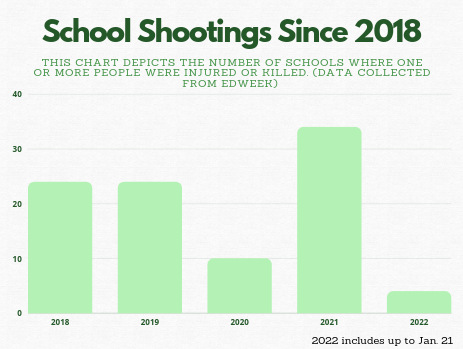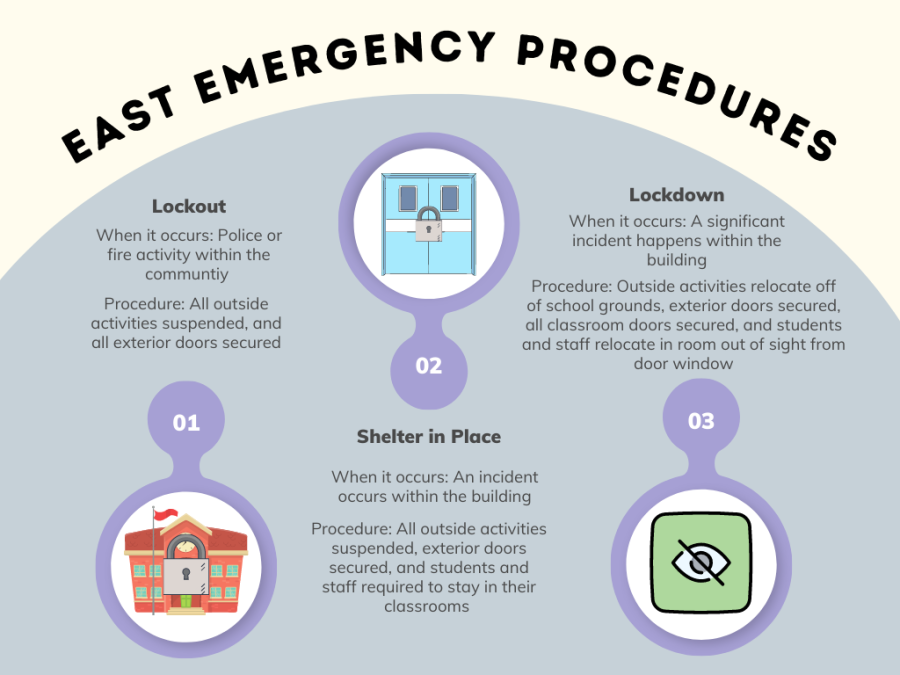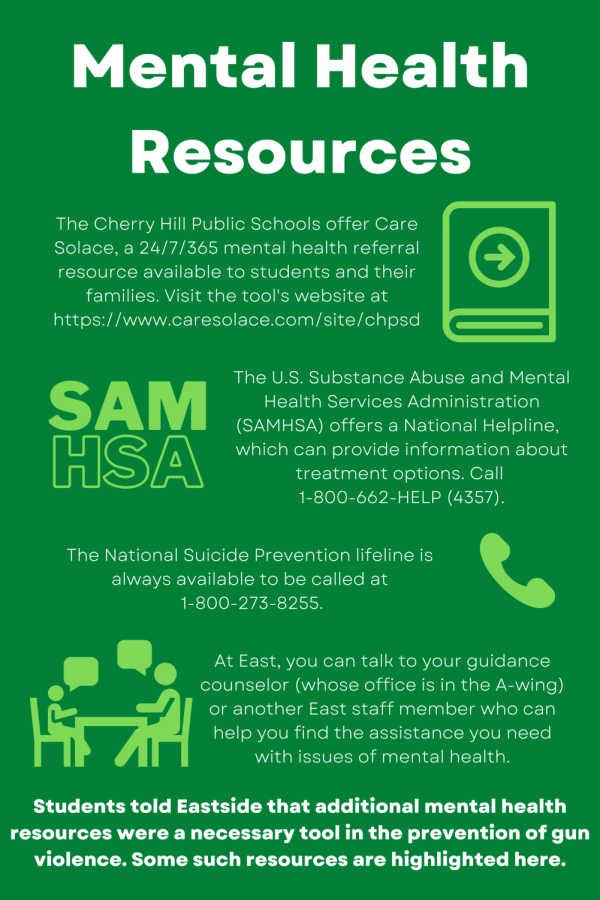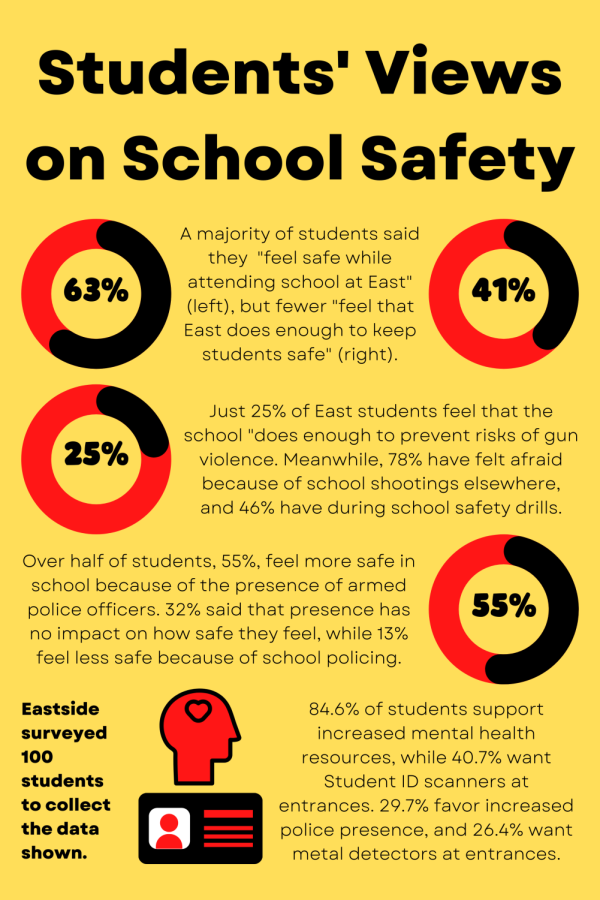Gun Violence: A Continuing Tragedy
February 27, 2022
For years on end, students would dread walking into school due to the overload of homework and the misfortune that is boring teachers and lessons, but today, students dread walking into school for a much different reason — gun violence. Students now have to fear for their safety when walking in the doors of their school. Parents note what clothes their child wears to school each day. It seems as though every couple of months, adults and children alike turn on the news to learn that there has been another school shooting. This multimedia package seeks to dive deeper into the tragedy that is school shootings and discover how it is impacting us.
CHPS Director of Security addresses our current preventative measures
Each school in Cherry Hill performs emergency procedure drills in order to ensure the safety of CHPS students in the case of an emergency.
“It’s natural to feel fear… fear is a part of our lives.” Those were the honest words of Anthony Saporito, the Director of Security for the Cherry Hill Public Schools (CHPS), addressing concerns about school safety and gun violence.
Over recent years, anxiety about school shootings has risen, especially in times when high-profile events of violence have recently occurred. While Saporito recognized the validity of such concerns, he also assured that his department is working to keep Cherry Hill’s schools safe.
While Saporito said that some measures remain confidential “so that they don’t get into the hands of the bad people,” he did detail some of the actions taken in the prevention of school gun violence.
First of all, he said, buildings remain locked throughout the school day. When visitors need to enter the building, secure procedures are used to ensure they have an appointment and are allowed to enter. If someone is dropping something off, some CHPS buildings have security vestibules that limit the visitor from ever entering the main school building.
Beyond these initial measures, Saporito stressed that security staff “rely on intelligence.” From building relationships with parents and staff members to collaborating with the Cherry Hill Police Department, CHPS security staff work to ensure that they will find out about any threat with time to prevent it. Saporito said that when it comes to the issue of school shootings, this is especially important; school shooters have been known to reveal their intentions to someone before ever committing the act.
“It’s a community,” Saporito said of the school security system. According to Saporito, campus police officers are always working to maintain communicative relationships with other parts of school staff, such as counselors and administrators. He said that anyone in the community with information about security risks should tell that information to anyone with whom they are comfortable, whether it be a police officer or a teacher or a custodian, with the trust that such information will immediately be passed on to the necessary authorities.
Certain security measures remain unavailable in the school environment. For example, Saporito outlined extensive logistical challenges that would make the addition of metal detectors at school doors infeasible. As such, some level of risk will always remain.
Ultimately, Saporito urged members of the CHPS community to “be responsible” and do their part in preventing risks of gun violence in schools. From keeping guns stored and locked responsibly to reporting any important information, students and families can help respond to fear with proactivity and prevention.
Communities across the country have made their voices heard

This chart represents how many schools have been affected by gun violence where one or more people have been injured or killed.
False alarm. The loud “Bang” in the hallway is just the noise of binders being dropped on the floor. Teachers gradually remove magnetic locks that had been installed into place, and hesitantly proceed with class. Shocker: this situation is an extremely common one to students in the 21st century. Through the years, mass shootings have spread from school district to district, and have produced some of the nation’s most infamous shooting cases, such as Oxford, Sandy Hook, Stoneman Douglas, and more.
Numerous student-led protests have expanded in regards to the school shooting in Oxford, Michigan that resulted in the arrest of Ethan, James and Jennifer Crumbley, and others over the years. Several organizations have thus been formed, such as Sandy Hook Promise, an organization that specializes in ensuring that all children in school are protected from any threats. It was established in honor of the Sandy Hook victims that were killed as a result of the shooting there in 2012. Through the Sandy Hook Promise Action Fund, youth leaders are able to focus on specific issues, such as background checks on gun sales, Extreme Risk Protection Orders to support law enforcement or family members attached to gun-related crime issues, and the STOP School Violence Act. This act, which has passed in the United States House of Representatives, presents itself as bipartisan safety legislation expanding access to school violence protection programs across the country. These measures have proven beyond successful; currently, upwards of 12 million individuals have contributed towards ending this tragedy of school shootings.
Students are petrified. Staff members are helpless. Yet, we can continue to act. By aligning with organizations and promoting the forming of anti-gun-violence clubs at school, students can further efforts towards establishing schools nationwide as safe spaces. There is still so much to accomplish, and so much to hope for.
What role does social media play in school shootings?
As time changes and technology evolves, so do threats to student safety. Nowadays, potential school shooters can be found lurking on social media and leaving key traces of their future intent behind. However, it appears that the infamy granted to such individuals also incentivizes their inflammatory language. This phenomenon was put on full display earlier this year, as police responded quickly to threats posed against Cherry Hill High Schools East and West.
A message circulating on Snapchat included vague threats against the safety of students attending school on December 14th, creating fear in the West student-community. Rather than go into lockdown, the Cherry Hill Public Schools district increased police presence at West due to Lt. John Moyer deeming the language of the threat as “generic” and non-credible. This instance follows a peculiar trend amongst certain teenagers on social media.
Later in that same week, police presence increased at East due to similar threats. A niche internet challenge which found home on the popular social media platform TikTok, dubbed the “Shoot Up Your School Challenge” and “National Shoot Up Your School Day,” impacted schools nationwide. Users posted threatening and inflammatory language, which consequently led to concern for student safety on December 17th at East. This came in direct succession to the recent school shooting in Oxford, Michigan, as well as the anniversary of the Sandy Hook Massacre, which occurred on December 12, 2012.
It appears that a certain sect of American teenagers view the recent flurry of school violence as a trend, which resulted in numerous instances of threatening language. While this impacted life in Cherry Hill, it has also extended further and troubled schools across the country.
However, the role of social media also has a notable history of immense benefit when it comes to combating school violence. Thousands have banded together to join the March for Our Lives movement, creating a space for young people to affect gun reform change while organizing online. Ryan Deitsch, a graduate and survivor from the shooting at Marjory Stoneman Douglas High School in Parkland, Florida, recalled how after a school shooting occurs, he receives messages on Instagram from those affected via the March for Our Lives account.
“Social media is the double-edged sword of the modern age, with these direct messages bringing comfort and strength to those seeking ceasefire and message boards fueling the fire they wish to cease,” he wrote.
While there are obvious positives and obvious negatives, the role of social media in this issue does not seem to be going away any time soon. As the lives of everyday Americans become more entwined with technology, an organizational change in how dangerous acts are committed ought to be expected. Given this, society must continue to adapt to these evolutions, yet remain on high alert when threats arise.
“If you, or your children, have questions or concerns, please reach out to the school, or to the district, or to me directly,” wrote Superintendent Dr. Meloche. “Voicing concerns in this manner helps us all keep each other safe.”
What schools have been impacted since September, 2021?
Between August 13 and Jan 21 of the 2021-2022 school year, many schools have faced the threat of gun violence. This map aims to show the schools where one or more people have been injured or killed as a result of gun violence.
A closer look at some of the most well-known school shootings since the massacre at Columbine High School
How does mental health factor into school shootings?
Cherry Hill East and other mental health organizations has made sure to make their resources available for anyone who is seeking help.
Surprisingly, in the midst of the COVID-19 pandemic, gun related violence has increased significantly as compared to past years. This is especially true in certain major cities such as Los Angeles, Chicago, and Baltimore. The American Journal of Emergency Medicine offers some explanations, such as that of people experiencing financial crisis from unemployment, the increased sale and consumption of alcohol, and increased firearm purchases. What impacts does this have? Specifically, how does this national crisis impact educators and children in U.S. schools? Well, in the United States of America, school shooting drills have sadly become very common. With these drills come significant anxiety and fear. Not only are parents terrified of the unspeakable happening, but students are being affected in damaging ways as well.
It is hard to ignore that the precautions that schools take to protect their students can cultivate worry and anxiety in students, especially when schools conduct active-shooter drills and lockdowns. According to the Child Mind Institute at Palouse River Counseling, more and more schools are conducting these drills, but schools that “try to make the drills as realistic as possible risk scaring students (and teachers,) and miss the point of these drills in the first place.” The institute suggests that teachers who talk about active shooters should do so with confidence and should ensure that their students know that the school will take necessary precautions to protect their students’ safety.
Another factor that contributes to the uneasiness that U.S. students may feel coming to school is the way shootings are covered on television and social media. The way in which tragedy is displayed is certainly quite intense. Media coverage can dominate the minds of parents, and children can then sense their parents worry, leading them to feel afraid themselves.
According to a survey conducted by the Pew Research Center, 25% of U.S. teenagers claim that they are very worried, and 32% say they are somewhat worried, about a shooting occurring at their school. These percentages amount to more than half of U.S. teens, which is very concerning to say the least. It is also apparent that some students view mental illness checks, weapon bans, and metal detectors in schools as effective ways to implement safety measures. Most teens do not support the gun lobby’s efforts to allow students and staff in colleges and universities to carry guns because this could potentially lead to accidents and create an apprehensive environment that would not feel safe despite opposite intentions.
This begs another question: how likely is it for students to bring an armed weapon to school? There are many instances in which a gun can be found in a student’s possession at school, such as for a kid to show off to friends or for protection and in case of a fight breaking out. However, kids may not really understand the implications of bringing a weapon, and many states in the U.S. do not require parents to keep their guns in a secure place. Students can get expelled or even arrested for being caught with a weapon. The Centers for Disease Control (CDC) say that 5.4% of teens in the U.S. have been caught with a weapon. Therefore, schools must be vigilant, especially when it comes to kids who potentially could act in violence. Instability at home, having parents in the military, and being bullied at school are also factors that can contribute to the percentage of kids bringing guns to school. Victims of bullying are twice as likely to bring weapons to school than those who are not bullied, according to the CDC. However, it is important to mention that researchers claim that if a student’s safety is not being endangered, they are very unlikely to bring a gun to school, despite being a victim of bullying or harassment at school. Students that experience physical threats numerous times are more likely to want to act out violently or ensure protection at school through firearm possession.
To avoid this, U.S. schools should focus more on making sure that all students feel safe. The U.S. must break this pattern of students fearing for their own safety in order to decrease the likelihood of students creating dangerous situations with weapons at school. Student mental health and safety should be prioritized above all else.
How can we fight gun violence in our schools?
When 100 students at Cherry Hill East were surveyed, students weighed in on their thoughts regarding our current preventative measures.
Across the globe, schools have been plagued with the threat of gun violence. Elementary schools and colleges alike experience the same threat of gun violence; in recent years, the danger has become more prominent.
With these rising concerns come new preventative measures being installed into school districts across the nation. Many are aware of some of our current preventative measures, like school safety drills (lockdowns, lockouts, etc,) but it is important to ask: how much safety can these drills provide?
Of course, nothing can be 100% safe – that’s impossible. However, there are certainly other preventative measures that could be taking place throughout the Cherry Hill Public Schools district. For one, implementing mental health screenings and providing more mental health resources in all schools across the district could greatly aid in this pursuit.
Personally, I feel physically safe everyday in the Cherry Hill High School East building, but that does not eliminate the fear factor I get when hearing about school shootings across the country. The inevitable questions are raised. What if that happens to my school? Why is this happening? Do the adults even care anymore? And oftentimes, I see that those who are bringing guns to school are mentally unwell. It frustrates me, as I’m sure it does many other students. How come this mentally unwell person had access to a gun?
As young adults, I feel that Cherry Hill East students are aware that we cannot possibly ensure complete safety amongst every scenario, but it seems as if in this day and age, the risk of gun violence is becoming more prominent, and that must change.
We have safety measures like safety drills, security presences, and the installation of security vestibules throughout our district, which is so appreciated by students and staff; yet, just because we have these safety measures does not mean that we can give up on finding more solutions. This issue needs to be constantly addressed. If the shooters will not stop, then neither will we.
I am satisfied with our current preventative measures, but moving forward, I think that there needs to be a continued emphasis on school safety. Involve students in the conversations. What will make us feel more comfortable coming to school every day? There are many additional safety measures out there, and it is up to the Cherry Hill Public Schools district as to whether we will continue to implement them.



